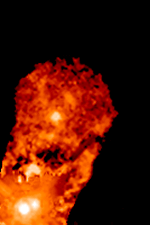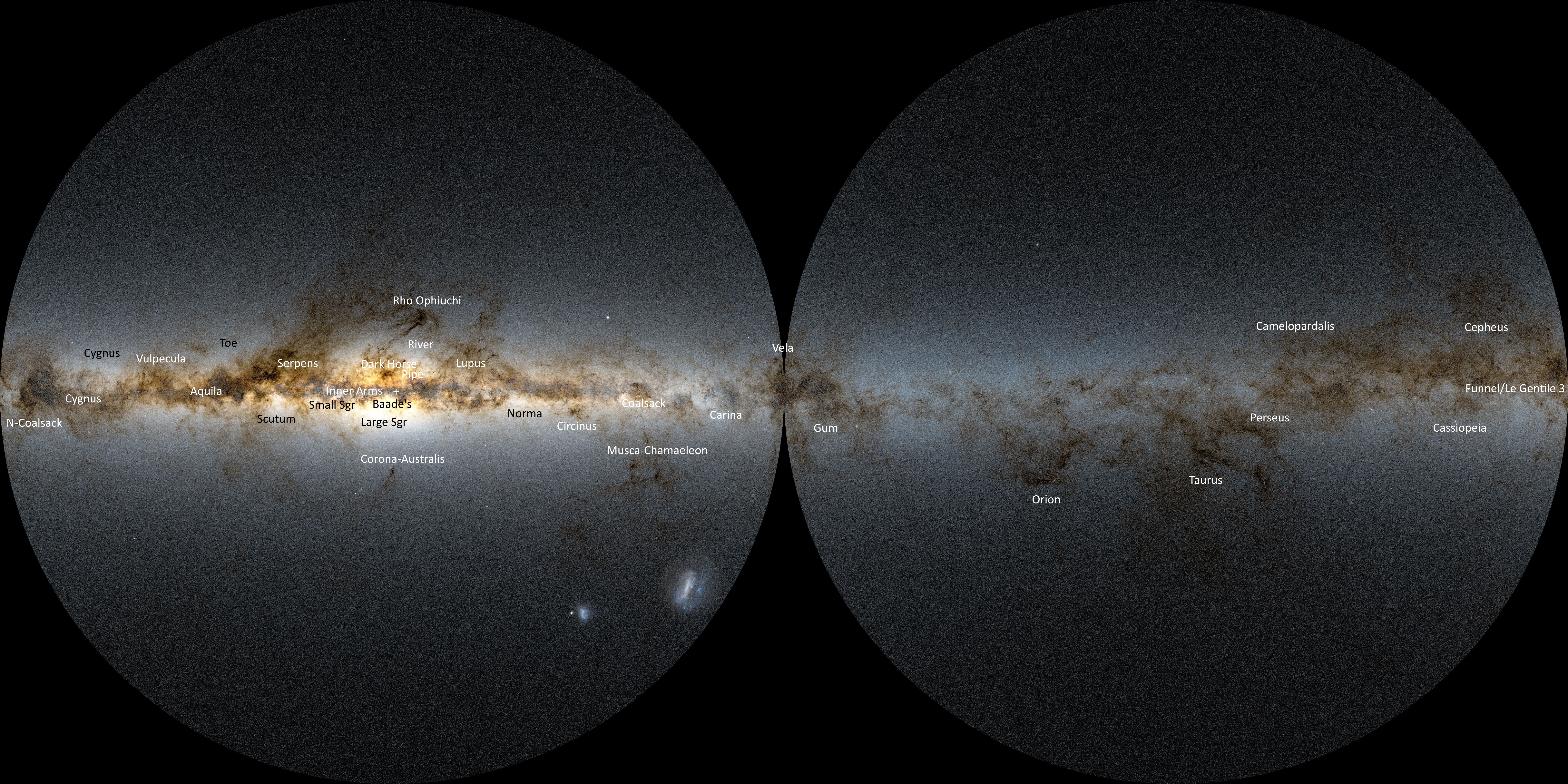|
Barnard 30
Barnard 30 is a dark cloud in the Lambda Orionis ring, north of Lambda Orionis, also called Meissa. The region is about 1300 light years from Earth. The Barnard 30 cloud is one of the regions in the Lambda Orionis Ring where the population of young stars is concentrated, together with the Lambda Orionis cluster and Barnard 35. It contains Herbig-Haro Objects, young stars, brown dwarfs and multiple T Tauri stars. The young population includes HK Orionis, a Herbig Ae/Be star and HI Orionis, a T Tauri star. The stellar population in Barnard 30 is about 2-3 million years old and is therefore significantly younger than the central Lambda Orionis cluster. This cloud is likely shaped by the massive star Meissa and this star is also responsible for triggering star-formation in this cloud. A possible supernova 1 million years ago that possibly has formed the Lambda Orionis ring might be an additional trigger for the star-formation in this region. The region contains a reflection ne ... [...More Info...] [...Related Items...] OR: [Wikipedia] [Google] [Baidu] |
Sig07-006
Sig used as a name may refer to: *Sig (given name) *Sig, Algeria, a city on the banks of the Sig River *Sig Alert, an alert for traffic congestion in California, named after Loyd Sigmon *Sig River, a river of Algeria also known as Mekerra sig (lower case) may refer to: *sig (rune), an Armanen rune, later used for the Schutzstaffel (SS) logo *sig, the distinctive hand actions of sign language that form words; see movement (sign language) * .sig, a signature block in e-mail messaging ''sig'' as a loanword may refer to: *''sig'' (Russian), the common whitefish; see ''Coregonus'' *''Sig'' (Italian), abbreviation of ''Signore'' ("Lord") *''Sig.'' (Latin, also ''Signa'' or ''Signatura''), the "signature" section of a medical prescription, which contains directions to the patient, and the signature of the prescribing doctor *Sig. Signaling ( in R''ail transport'') the signals and associated equipment required for their operation. SIG (capitalized) may refer to: *SIG, the IATA Callsign o ... [...More Info...] [...Related Items...] OR: [Wikipedia] [Google] [Baidu] |
T Tauri Star
T Tauri stars (TTS) are a class of variable stars that are less than about ten million years old. This class is named after the prototype, T Tauri, a young star in the Taurus star-forming region. They are found near molecular clouds and identified by their optical variability and strong chromospheric lines. T Tauri stars are pre-main-sequence stars in the process of contracting to the main sequence along the Hayashi track, a luminosity–temperature relationship obeyed by infant stars of less than 3 solar masses () in the pre-main-sequence phase of stellar evolution. It ends when a star of or larger develops a radiative zone, or when a smaller star commences nuclear fusion on the main sequence. History While T Tauri itself was discovered in 1852, the T Tauri class of stars were initially defined by Alfred Harrison Joy in 1945. Characteristics T Tauri stars comprise the youngest visible F, G, K and M spectral type stars (). Their surface temperatures are similar to those ... [...More Info...] [...Related Items...] OR: [Wikipedia] [Google] [Baidu] |
Dark Nebulae
A dark nebula or absorption nebula is a type of interstellar cloud, particularly molecular clouds, that is so dense that it obscures the visible wavelengths of light from objects behind it, such as background stars and emission or reflection nebulae. The extinction of the light is caused by interstellar dust grains located in the coldest, densest parts of molecular clouds. Clusters and large complexes of dark nebulae are associated with Giant Molecular Clouds. Isolated small dark nebulae are called Bok globules. Like other interstellar dust or material, things it obscures are only visible using radio waves in radio astronomy or infrared in infrared astronomy. Dark clouds appear so because of sub-micrometre-sized dust particles, coated with frozen carbon monoxide and nitrogen, which effectively block the passage of light at visible wavelengths. Also present are molecular hydrogen, atomic helium, C18O (CO with oxygen as the 18O isotope), CS, NH3 (ammonia), H2CO (formaldehyde), c-C3 ... [...More Info...] [...Related Items...] OR: [Wikipedia] [Google] [Baidu] |
Orion Molecular Cloud Complex
The Orion molecular cloud complex (or, simply, the Orion complex) is a star-forming region with stellar ages ranging up to 12 Myr. Two giant molecular clouds are a part of it, Orion A and Orion B. The stars currently forming within the complex are located within these clouds. A number of other somewhat older stars no longer associated with the molecular gas are also part of the complex, most notably the Orion's Belt (Orion OB1b), as well as the dispersed population north of it ( Orion OB1a). Near the head of Orion there is also a population of young stars that is centered on Meissa. The complex is between 1 000 and 1 400 light-years away, and hundreds of light-years across. The Orion complex is one of the most active regions of nearby stellar formation visible in the night sky, and is home to both protoplanetary discs and very young stars. Much of it is bright in infrared wavelengths due to the heat-intensive processes involved in stellar formation, though the complex c ... [...More Info...] [...Related Items...] OR: [Wikipedia] [Google] [Baidu] |
Orion Nebula
The Orion Nebula (also known as Messier 42, M42, or NGC 1976) is a diffuse nebula situated in the Milky Way, being south of Orion's Belt in the constellation of Orion. It is one of the brightest nebulae and is visible to the naked eye in the night sky with apparent magnitude 4.0. It is away and is the closest region of massive star formation to Earth. The M42 nebula is estimated to be 24 light-years across (so its apparent size from Earth is approximately 1 degree). It has a mass of about 2,000 times that of the Sun. Older texts frequently refer to the Orion Nebula as the Great Nebula in Orion or the Great Orion Nebula. The Orion Nebula is one of the most scrutinized and photographed objects in the night sky and is among the most intensely studied celestial features.Press release,Astronomers Spot The Great Orion Nebula's Successor", Harvard-Smithsonian Center for Astrophysics, 2006. The nebula has revealed much about the process of how stars and planetary systems are form ... [...More Info...] [...Related Items...] OR: [Wikipedia] [Google] [Baidu] |
Reflection Nebula
Reflection or reflexion may refer to: Science and technology * Reflection (physics), a common wave phenomenon ** Specular reflection, reflection from a smooth surface *** Mirror image, a reflection in a mirror or in water ** Signal reflection, in signal transmission * Elastic scattering, a process in nuclear and particle physics * Reflection nebula, a nebula that is extended and has no boundaries * Reflection seismology or seismic reflection, a method of exploration geophysics Mathematics * Reflection principle, in set theory * Point reflection, a reflection across a point * Reflection (mathematics), a transformation of a space * Reflection formula, a relation in a function * Reflective subcategory, in category theory Computing * Reflection (computer graphics), simulation of reflective surfaces * Reflection (computer programming), a program that accesses or modifies its own code * Reflection, terminal emulation software by Attachmate Arts and entertainment Film and television * ... [...More Info...] [...Related Items...] OR: [Wikipedia] [Google] [Baidu] |
Supernova
A supernova is a powerful and luminous explosion of a star. It has the plural form supernovae or supernovas, and is abbreviated SN or SNe. This transient astronomical event occurs during the last evolutionary stages of a massive star or when a white dwarf is triggered into runaway nuclear fusion. The original object, called the ''progenitor'', either collapses to a neutron star or black hole, or is completely destroyed. The peak optical luminosity of a supernova can be comparable to that of an entire galaxy before fading over several weeks or months. Supernovae are more energetic than novae. In Latin language, Latin, ''nova'' means "new", referring astronomically to what appears to be a temporary new bright star. Adding the prefix "super-" distinguishes supernovae from ordinary novae, which are far less luminous. The word ''supernova'' was coined by Walter Baade and Fritz Zwicky in 1929. The last supernova to be directly observed in the Milky Way was Kepler's Supernova in 160 ... [...More Info...] [...Related Items...] OR: [Wikipedia] [Google] [Baidu] |
Star Formation
Star formation is the process by which dense regions within molecular clouds in The "medium" is present further soon.-->interstellar space, sometimes referred to as "stellar nurseries" or "-forming regions", and form s. As a branch of , star formation includes the study of the |
HI Orionis
HI or Hi may refer to: Arts and entertainment * ''Hello Internet'', a podcast hosted by CGP Grey and Brady Haran * ''Hi'' (magazine), teen-lifestyle publication * "Hi" (Ofra Haza song), a song by Ofra Haza, Israel's entry in the 1983 Eurovision Song Contest * Hi, a character in the comic strip ''Hi and Lois'' * Hi Records, in music, a Memphis soul and rockabilly label * ''Hi'' (album), a 2021 album by Scottish band Texas ** "Hi" (Texas song), the title track * ''Hi'' (EP), a 2006 EP by Psapp * ''Hi~'', a 2015 repackage of South Korean girl group Lovelyz' 2014 album ''Girls' Invasion'' * "Hi", a song from the Xiu Xiu album ''Always'' Language * Hi (cuneiform), a cuneiform sign * Hi (kana), a Japanese written character * Hindi, an Indo-Aryan language (ISO 639-1 language code HI) * ''Hi'', a greeting in the English language similar to ''hello'' Organizations and events * Harlem International Film Festival, an annual five-day film festival * Hostelling International, a federati ... [...More Info...] [...Related Items...] OR: [Wikipedia] [Google] [Baidu] |
Herbig Ae/Be Star
A Herbig Ae/Be star (HAeBe) is a pre-main-sequence star – a young () star of spectral types A or B. These stars are still embedded in gas-dust envelopes and are sometimes accompanied by circumstellar disks. Hydrogen and calcium emission lines are observed in their spectra. They are 2-8 Solar mass () objects, still existing in the star formation (gravitational contraction) stage and approaching the main sequence (i.e. they are not burning hydrogen in their center). Description In the Hertzsprung–Russell diagram, Herbig Ae/Be stars are located to the right of the main sequence. They are named after the American astronomer George Herbig, who first distinguished them from other stars in 1960. The original Herbig criteria were: * Spectral type earlier than F0 (in order to exclude T Tauri stars), * Balmer emission lines in the stellar spectrum (in order to be similar to T Tauri stars), * Projected location within the boundaries of a dark interstellar cloud (in order to select re ... [...More Info...] [...Related Items...] OR: [Wikipedia] [Google] [Baidu] |
HK Orionis
Hong Kong ( (US) or (UK); , ), officially the Hong Kong Special Administrative Region of the People's Republic of China (abbr. Hong Kong SAR or HKSAR), is a city and special administrative region of China on the eastern Pearl River Delta in South China. With 7.5 million residents of various nationalities in a territory, Hong Kong is one of the most densely populated places in the world. Hong Kong is also a major global financial centre and one of the most developed cities in the world. Hong Kong was established as a colony of the British Empire after the Qing Empire ceded Hong Kong Island from Xin'an County at the end of the First Opium War in 1841 then again in 1842.. The colony expanded to the Kowloon Peninsula in 1860 after the Second Opium War and was further extended when Britain obtained a 99-year lease of the New Territories in 1898... British Hong Kong was occupied by Imperial Japan from 1941 to 1945 during World War II; British administration resumed after the ... [...More Info...] [...Related Items...] OR: [Wikipedia] [Google] [Baidu] |







